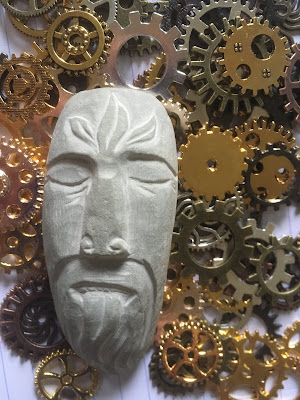 |
| Stone Head dated between 500BC and 500AD from Wentcliff Beck near Earby |
The Celts had a well known and documented reverence for the human head. The head, as the seat of the soul, was considered sacred. Ancient historians, such as Herodotus, described Celtic headhunters displaying their victims craniums with pride. To these iron-age tribesmen the power of the slain was appropriated by the collecting of heads. In this manner it is believed that Celtic warriors honoured their victims.
The idea of the head as the seat of the soul is reflected in many Celtic legends. The myth of Bran The Blessed is told in the Mabinogion, a collection of ancient tales in the Welsh language, and is just one example*. In this tale the seven survivors of the war between Matholwch and Bran bear the latter’s severed head back to Wales from Ireland. There they lived in a fort on an island off the coast for four score years and were known as The Assembly of The Wondrous Head. Bran’s severed head regaled them with tales, poems and songs, until one of their number opened a forbidden door and reality rushed in. The myth hints at the power assumed to reside within the head, even when it was no longer attached to the body.
Indeed this idea isn’t restricted to bloody tales of head hunters and singing severed heads prophesying the fates of lands and peoples. Stylised heads, carved in stone, were probably used as a focus for reverence. The symbolic head also appears on much metal work from the iron-age period throughout Europe. Such images often portray stern countenances, with large eyes and pronounced brows. They are thought to have been magical devices and were used to protect against evil.
 |
| This is one of my carvings - see the link below |
Indeed this idea isn’t restricted to bloody tales of head hunters and singing severed heads prophesying the fates of lands and peoples. Stylised heads, carved in stone, were probably used as a focus for reverence. The symbolic head also appears on much metal work from the iron-age period throughout Europe. Such images often portray stern countenances, with large eyes and pronounced brows. They are thought to have been magical devices and were used to protect against evil.
Wells, springs and lakes are associated with severed heads, and lingering remnants of ancient traditions involving human skulls and curative springs were still in use during the last century in Scotland and Wales. Old traditions often continued, even after the conversion of most ‘pagan peoples,’ albeit under the thin veneer of Christianity. Thus the head of Saint Fergus, who died circa 730 AD, was said to possess curative powers. In the 1400’s James IV had a silver case made for the skull. The head of another Saint, Marnoch,** also possessed healing powers and oaths were sworn by it, testament to the lingering notion that the head contained great power.
 |
| Stone head from York Museum. |
Notes:
* These texts relate the tales of the Brythonic speaking tribes who once inhabited Britain, up to the Forth Clyde isthmus
** He gave his name to Kilmarnock
Reference:
Druids - Anne Ross
Folklore of Lochs - MacKinlay
The Head Cult Tradition and folklore surrounding the symbol of the severed head in The British Isles - David Clarke.






